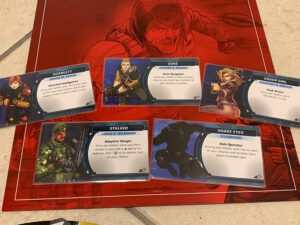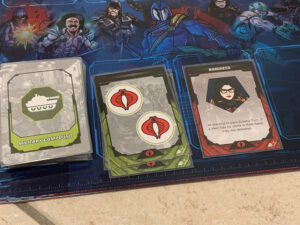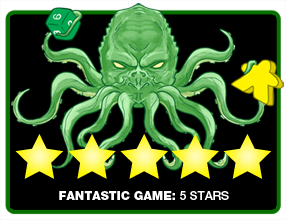 I’m a big child of the late 80s and early 90s. Thinking back, I have fond memories of many of the shows that were popular back then (and naturally, their associated toys…): Transformers, Teenage Mutant Ninja Turtles, Power Rangers, M.A.S.K., G.I. Joe, and more. Naturally, a couple of years ago when Renegade, the publisher of an excellent Power Rangers game called Heroes of the Grid, announced they would be doing deckbuilding games of a number of these classic 80s shows, my inner child was thrilled. Sometime after that, I learned that G.I. Joe was getting a miniatures game utilizing similar rules to Heroes of the Grid, and I may have run around the block screaming with glee. Ok, maybe not, but I was very excited! It was a melding of two things I love: G.I. Joe and Power Rangers: Heroes of the Grid.
I’m a big child of the late 80s and early 90s. Thinking back, I have fond memories of many of the shows that were popular back then (and naturally, their associated toys…): Transformers, Teenage Mutant Ninja Turtles, Power Rangers, M.A.S.K., G.I. Joe, and more. Naturally, a couple of years ago when Renegade, the publisher of an excellent Power Rangers game called Heroes of the Grid, announced they would be doing deckbuilding games of a number of these classic 80s shows, my inner child was thrilled. Sometime after that, I learned that G.I. Joe was getting a miniatures game utilizing similar rules to Heroes of the Grid, and I may have run around the block screaming with glee. Ok, maybe not, but I was very excited! It was a melding of two things I love: G.I. Joe and Power Rangers: Heroes of the Grid.
G.I. Joe: Mission Critical is a cooperative miniatures game for 1-6 players that takes 90-120 minutes to play. The best experience is with 5 players.
Gameplay Overview:
If you are familiar with Heroes of the Grid, you will probably instantly grasp 95% of Mission Critical. The rules have been mostly imported as-is with an eye toward cross-compatibility between the two games. The entire ruleset has been christened the Guardian System, with the implication that there will be other IPs under the same banner down the road.

Like its predecessor, the game is a cooperative form of tower defense. It has a Deployment Phase starting each round, in which Cobra’s troops, lieutenants, and Cobra Commander, progressively are placed on the board as dictated by a pre-constructed deployment deck. The rest of the round, the ball is in the Joe’s court. Each player has a number of actions that vary with the player count that they can spend to heal up, move around the board, or initiate battles with Cobra. The round concludes when all the Joes have used those actions.
The goal of this system is to survive through the early rounds, beating back the enemies as they come, in order to make it to face and defeat the final boss (in this core set, Cobra Commander). Typically this takes four rounds, though if you’re unlucky the boss can potentially show up during round 3. Most of the action in the game ultimately takes place during battles (one of the actions Joes can take). In these battles, the Joes work together to decide which cards, attacks, and choices their team will use, while also mitigating the incoming attacks from Cobra’s cards. The “A.I.” for resolving the enemy side of battles is very simple, yet effective. Should the Joes fail to defeat enough enemies and Cobra overruns the board—or if too many Joes fall in battle—Cobra wins!

Game Experience:
The Action Phase is the meat of the gameplay, especially the battle actions therein. Mission Critical comes with a battle board that makes the setup more structured and visual. The enemy cards are lined up in either one or two rows of at most 4 cards each (lieutenants or the boss on top, foot soldiers on the bottom). Each of these enemy cards resolves its listed effect (often, damage, draining energy, forcing the Joes to discard), while the Joes can play cards between each of those enemy resolutions. The goal throughout the battle is to mitigate the incoming negative effects by “defeating” cards; that is, by dealing damage to a card equal to its listed amount of health. If a card is defeated, it is flipped facedown, and will still take an enemy turn to resolve (with no effect).

One of the aspects of this system that continues to impress me, even after many countless plays of Heroes of the Grid, is the way your personal Joe’s combat deck is designed to be both their resources, as well as their health that keeps them in the fight. You need to get cards into your hand to play them, but the more cards you draw, the weaker you can potentially be. Damage or enemy effects can more easily empty your deck and defeat you (sending you back to The Pit) if you leave your deck too vulnerable. There are a lot of decision-making points in this system, but that is one that is fairly universal to all characters, and it is carried over into Mission Critical. The deck sizes remain at 10, so you only have a little bit of wiggle room before it starts getting dangerous.
But this is an IP game, so the theme is very important. It has a solid mechanical foundation laid for it, but if it was just Joe art and characters shoehorned in, I think it would fall flat. The many aspects that go into a character have allowed the system to be thematic in general, and that is still true in Mission Critical. If a person is familiar with G.I. Joe, each character, both Joe and Cobra, has recognizable nods to the source material. Cobra Commander has a lot of cards utilizing his troopers instead of directly engaging you. Duke specializes in making the entire team excel as a leader. Cover Girl is a vehicles expert, and so on.

Another key way the thematics of G.I. Joe are captured is the Vehicles. They are a huge component of the game. They are your trump cards. Your aces in the hole. Your Swiss Army knife. During every battle, there are three Vehicles face up in the “hangar.” During battle, you can “spend” a number of previously defeated foot soldiers indicated on each vehicle to use that vehicle’s ability. There are six Vehicles included in the core set with a fairly wide range of possible abilities.
Ultimately, this is a cooperative game, and it can get a little difficult. As with any cooperative game that is worthwhile, the key to overcoming the challenges lies in working together with your team… your fellow Joes, in this case. Most battles with lieutenants and bosses will have multiple Joes present. Each Joe is unique with their own strengths and weaknesses, and under most normal circumstances, the Joes can only play one card per hero turn. This leads to a lot of conversation and problem solving, searching for the right play at the right time. If you don’t have an answer to the current situation, one of your teammates might. Maybe your teammates can see a card combo that you just didn’t notice. That interaction contributes to a shared sense of ownership over your success or failure. Everyone gets to participate.

I would be remiss if I did not talk a bit more about the cross-compatibility between Mission Critical, Heroes of the Grid, and future entries in the Guardian System. In short, the two are meant to be wholly interchangeable. You can bring just Rangers into a game with Joes and Cobra, or vice versa; or you can do a mix somewhere in between. Most of the heroes and enemies slot into the opposite game without too much difficulty. The primary difference between the two are the Vehicles and Zords. The foot soldiers that you spend to use Vehicles, you can also use to unlock the Zords and the Megazords, but cards affecting one, do not affect the other. Otherwise, it’s pretty much the same. Some terms and icons have been standardized, and there’s a helpful little chart for that in the rules.
Final Thoughts:
There was certainly some potential risk here. Using the existing system could have felt slapped on, and just cashing in on the IP. When I first was offered the opportunity to playtest an early version of this, I was worried that it would not have felt unique enough to warrant the effort. The result does not warrant that concern. G.I. Joe is a very natural fit for the system. It is almost a better thematic fit than Power Rangers was, so I am actually surprised I did not see this coming when Renegade first announced they were expanding their Hasbro partnership to include G.I. Joe games.

I was already a big fan of this rules system thanks to Heroes of the Grid, and the theme delivered so well that Mission Critical will be joining Heroes of the Grid as one of my favorite cooperative games. The rules system is easy to understand and explain, but has strategic depth there as well. Winning a game can be difficult for inexperienced players, and even for experienced players, some of the enemies can be a real challenge. You are pushed to overcome those challenges with teamwork, and when you come up with and successfully execute a plan as a group, it is very rewarding.
There has been some criticism over the size of the Guardian System miniatures, as they are much larger than miniatures you might find in an RPG. I find it to be one of the game’s strengths. It is a miniatures game, not an RPG, so the miniatures need to be eye-catching. At this size, they lend themselves to a lot of detail, both painted and unpainted, and look great on the table.
If you like cooperative games, this is one to try. It does everything you want a good cooperative game to do. Currently, there are only a limited amount of expansions, but there will probably be more on the way. I expect the game will have nearly limitless replay value after a few more expansions. The integration with Heroes of the Grid—which is fairly seamless—already allows for a mind boggling amount of possibilities. If you’re already a fan of Heroes of the Grid, the ability to mix them will just give you more of what you enjoy.
Final Score: 5 Stars – Mission Critical is a successful take on an already great system. It has simplicity and ease of gameplay without sacrificing depth or challenge. Great cooperative game.
 Hits:
Hits:
• Gameplay in battles is strategic, yet simple.
• Nice, big and detailed high-quality miniatures.
• Crossover potential with Heroes of the Grid (and future Guardian System games).
• Great theming. The Vehicles in particular make it feel like G.I. Joe.
Misses:
• If you don’t like randomness in your games, most Joe attacks use dice.
• Some might prefer smaller miniatures.






















